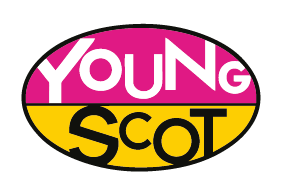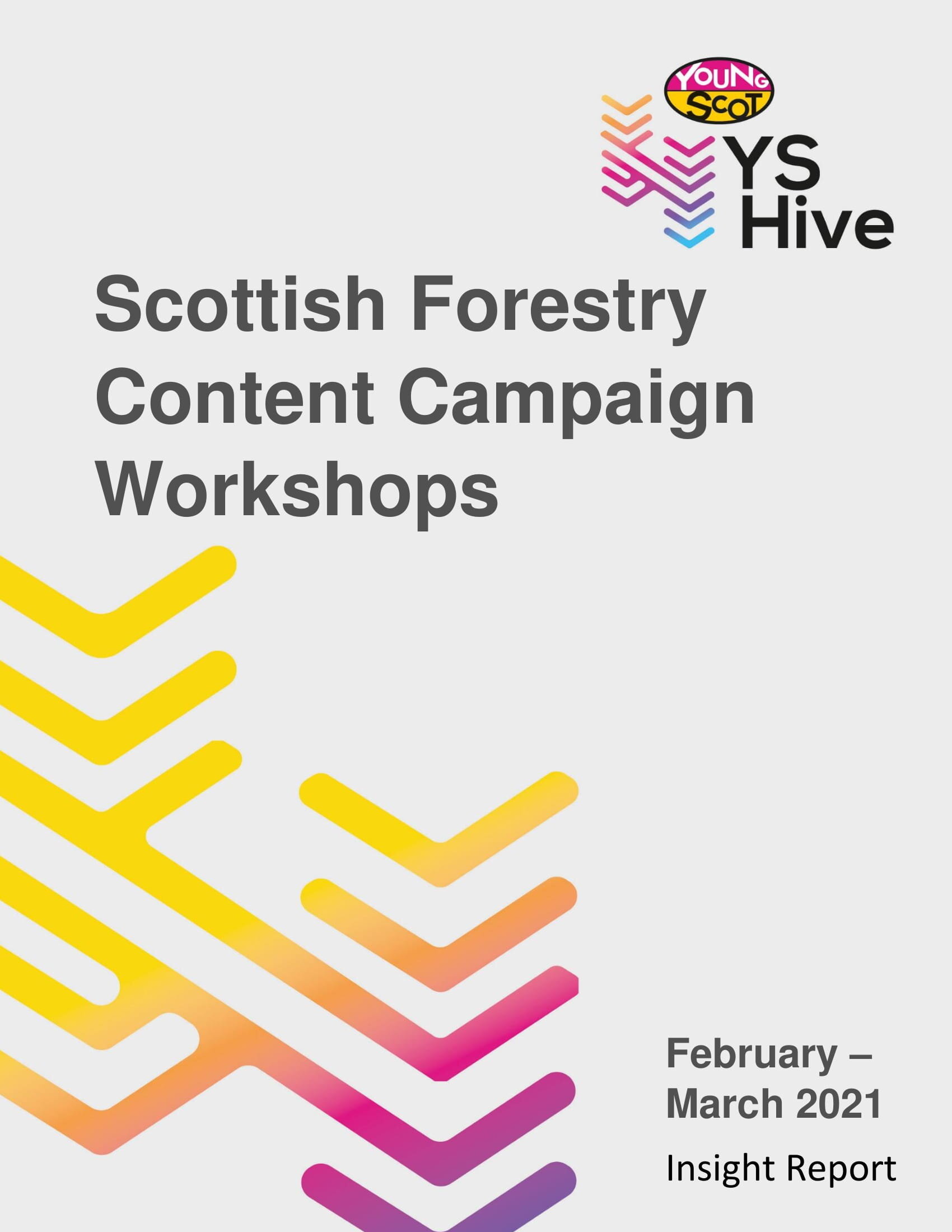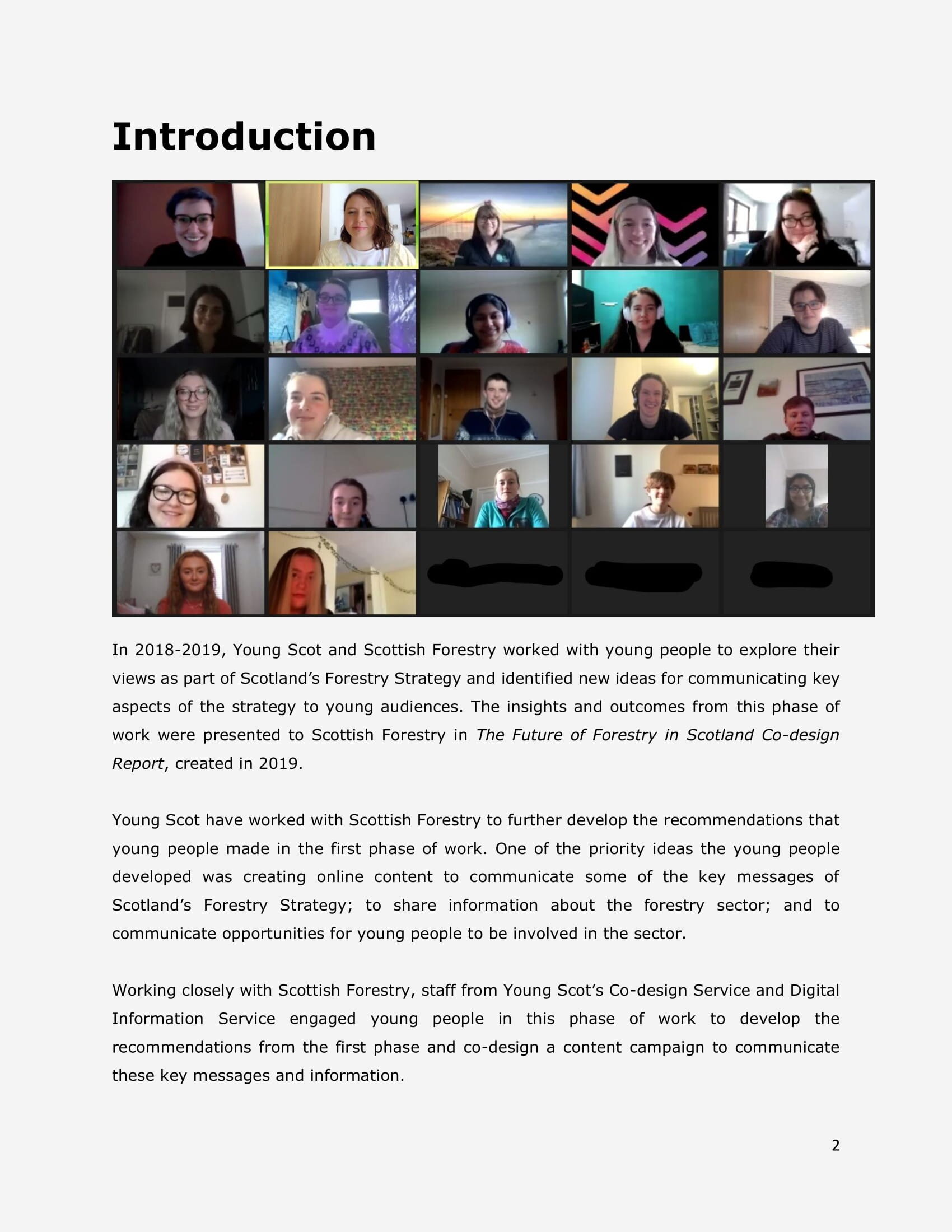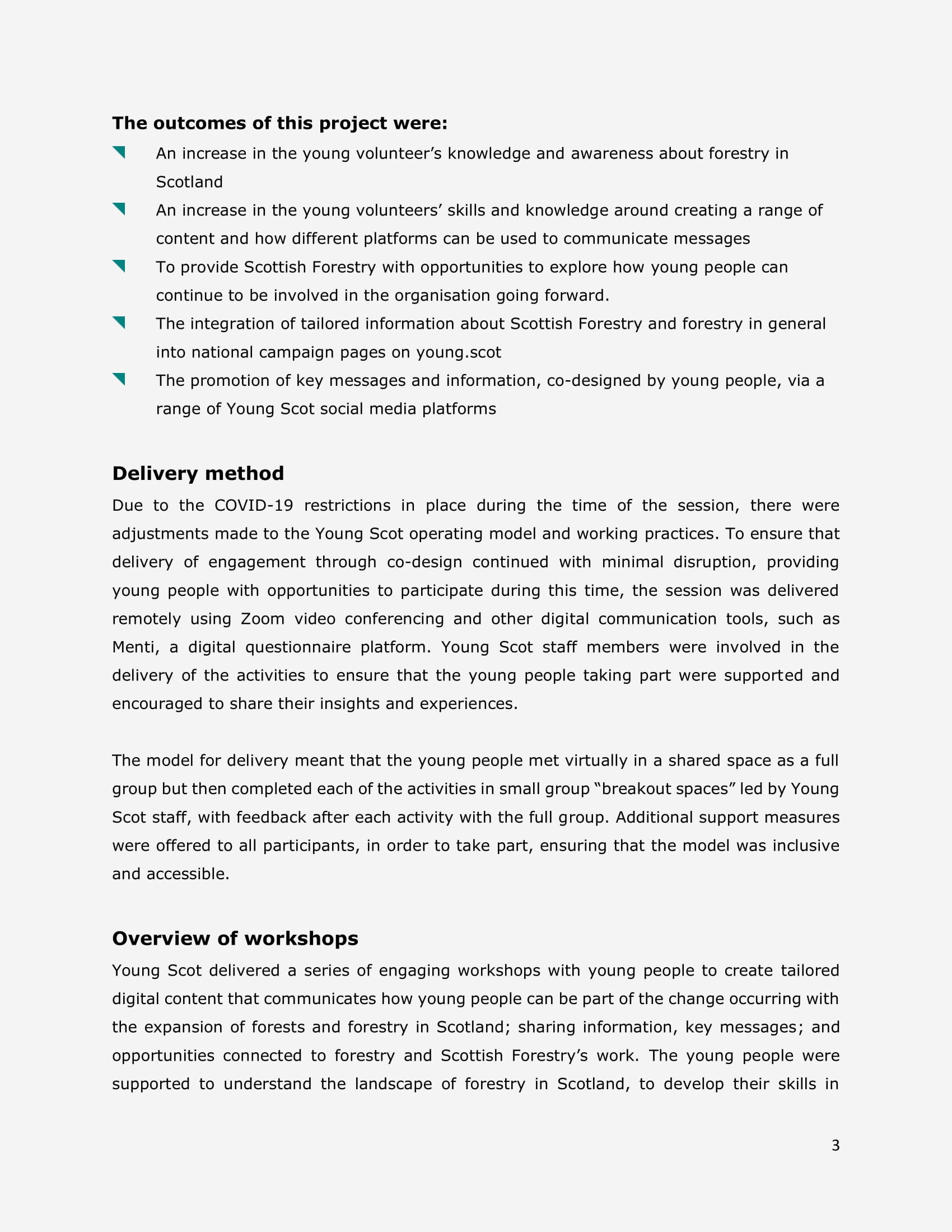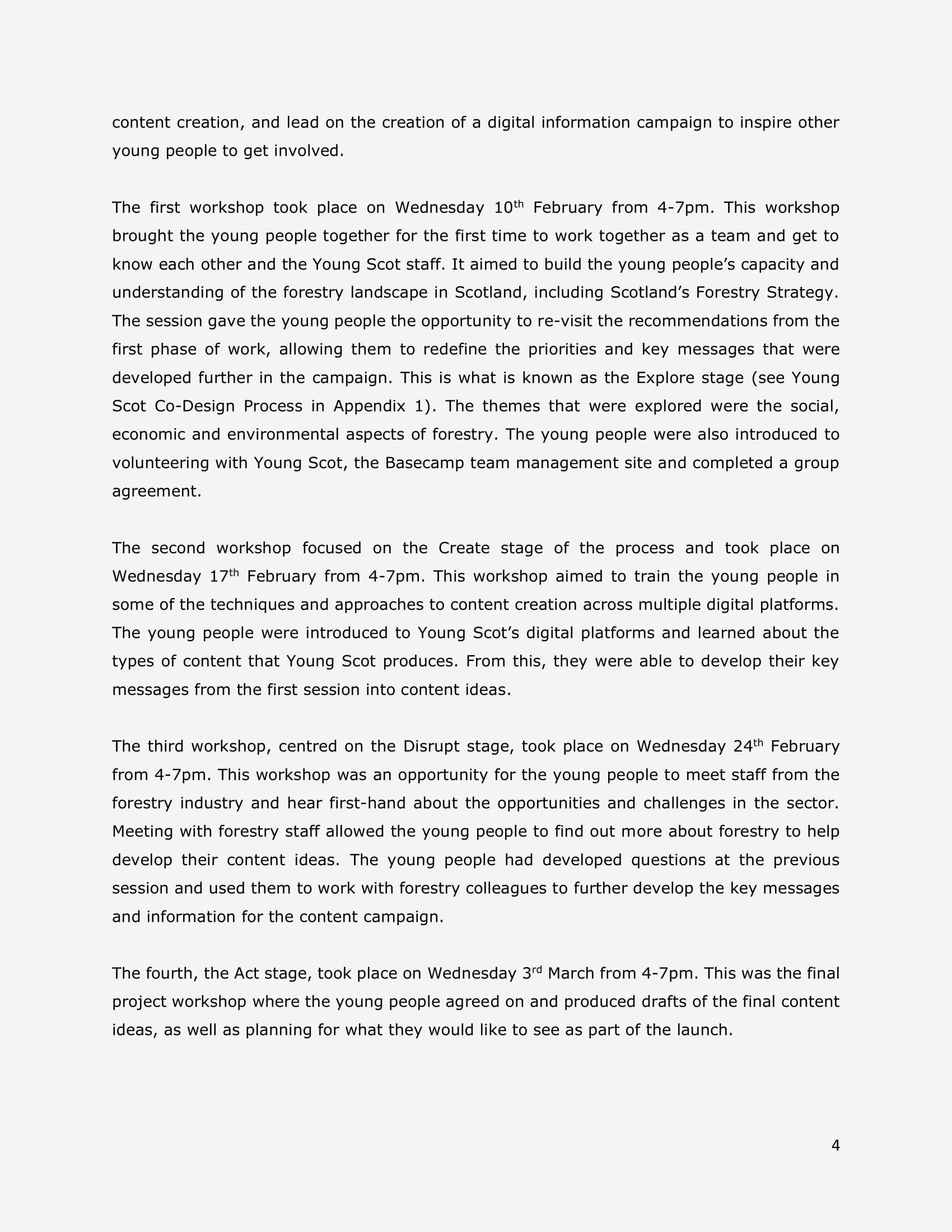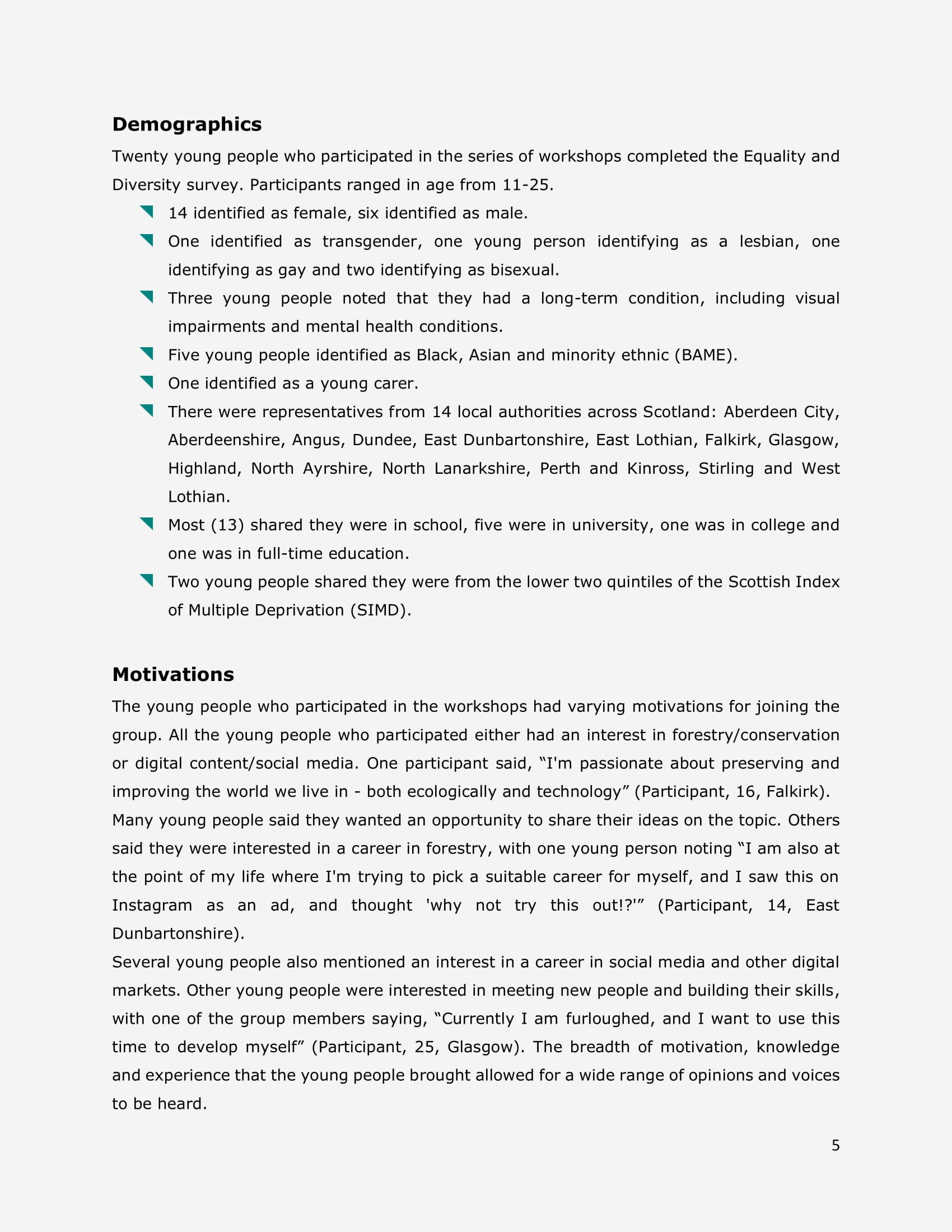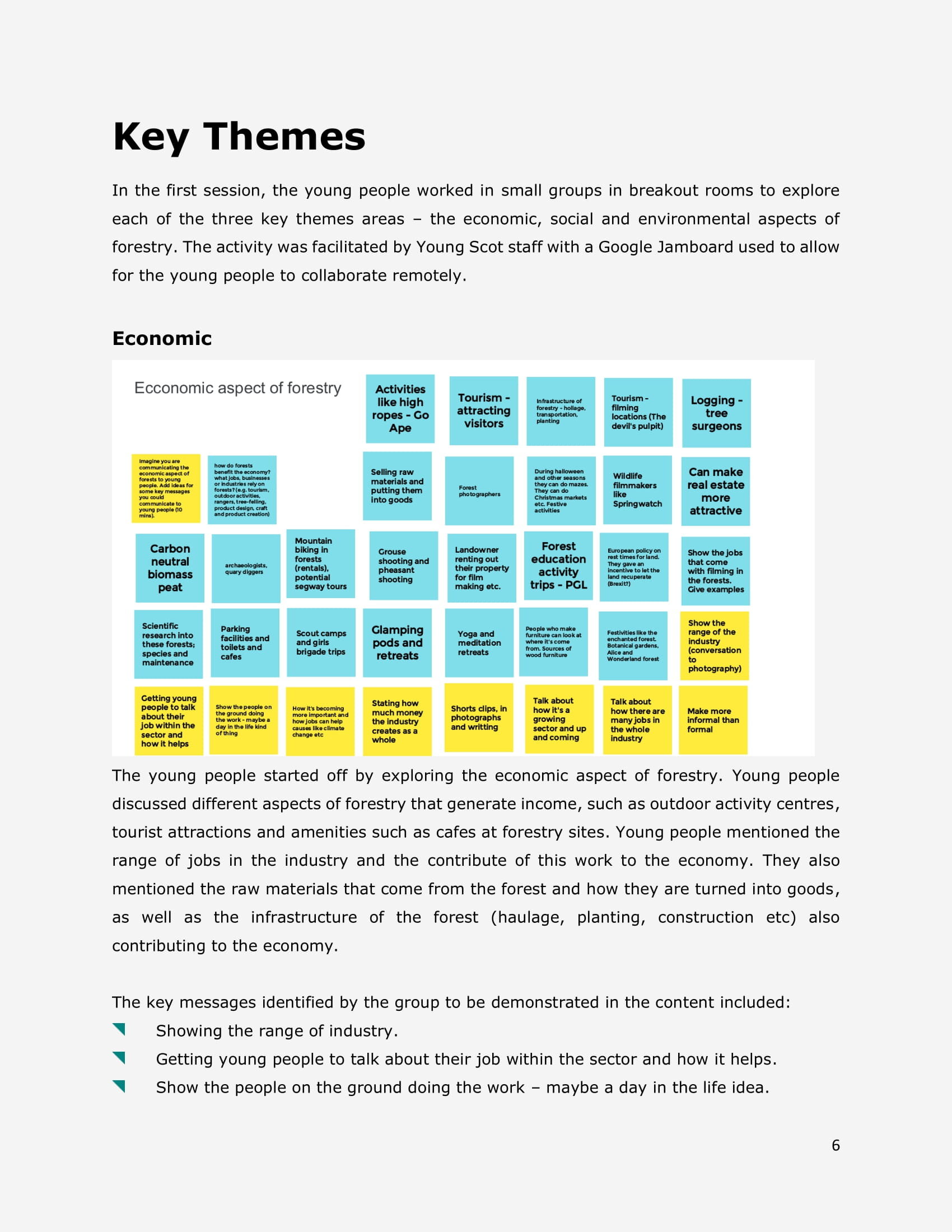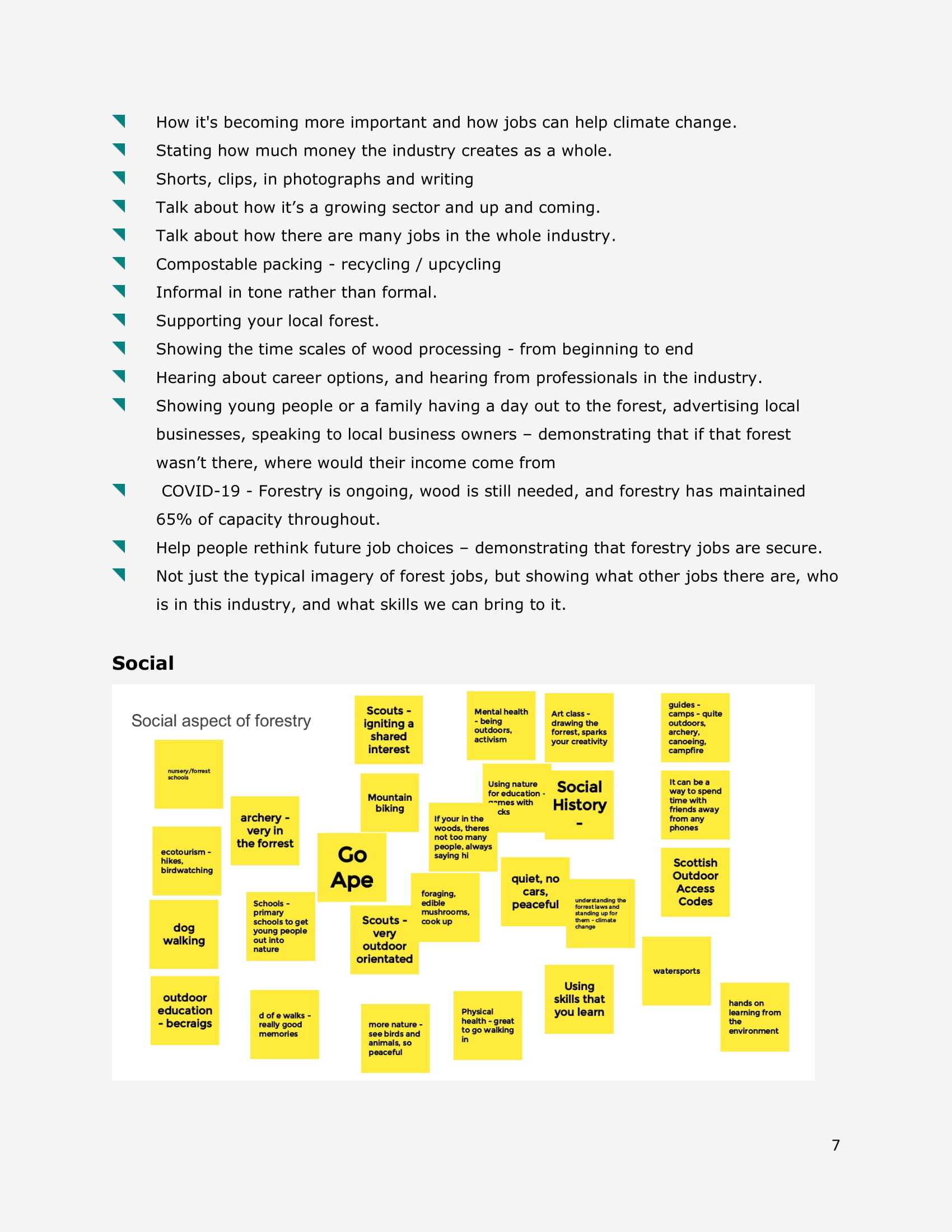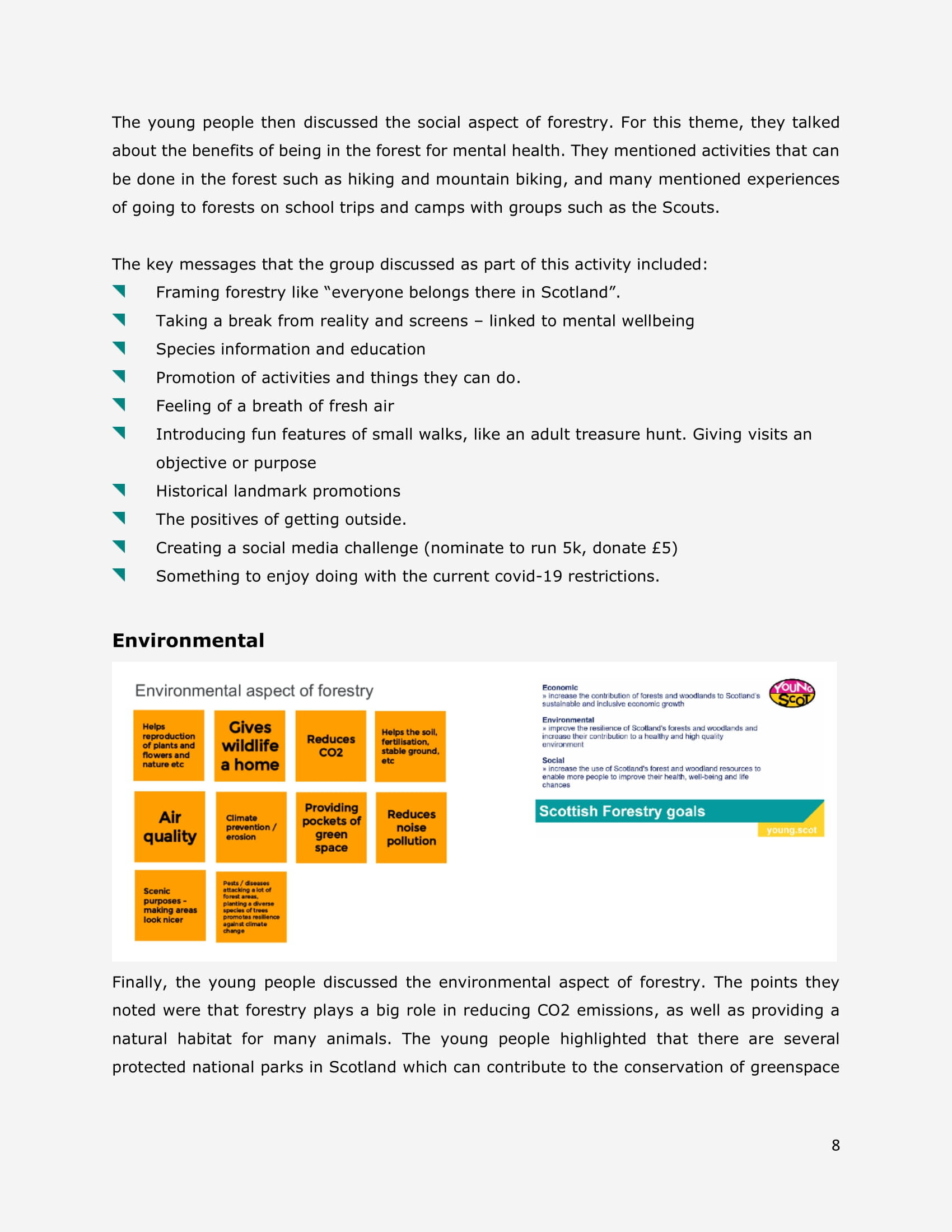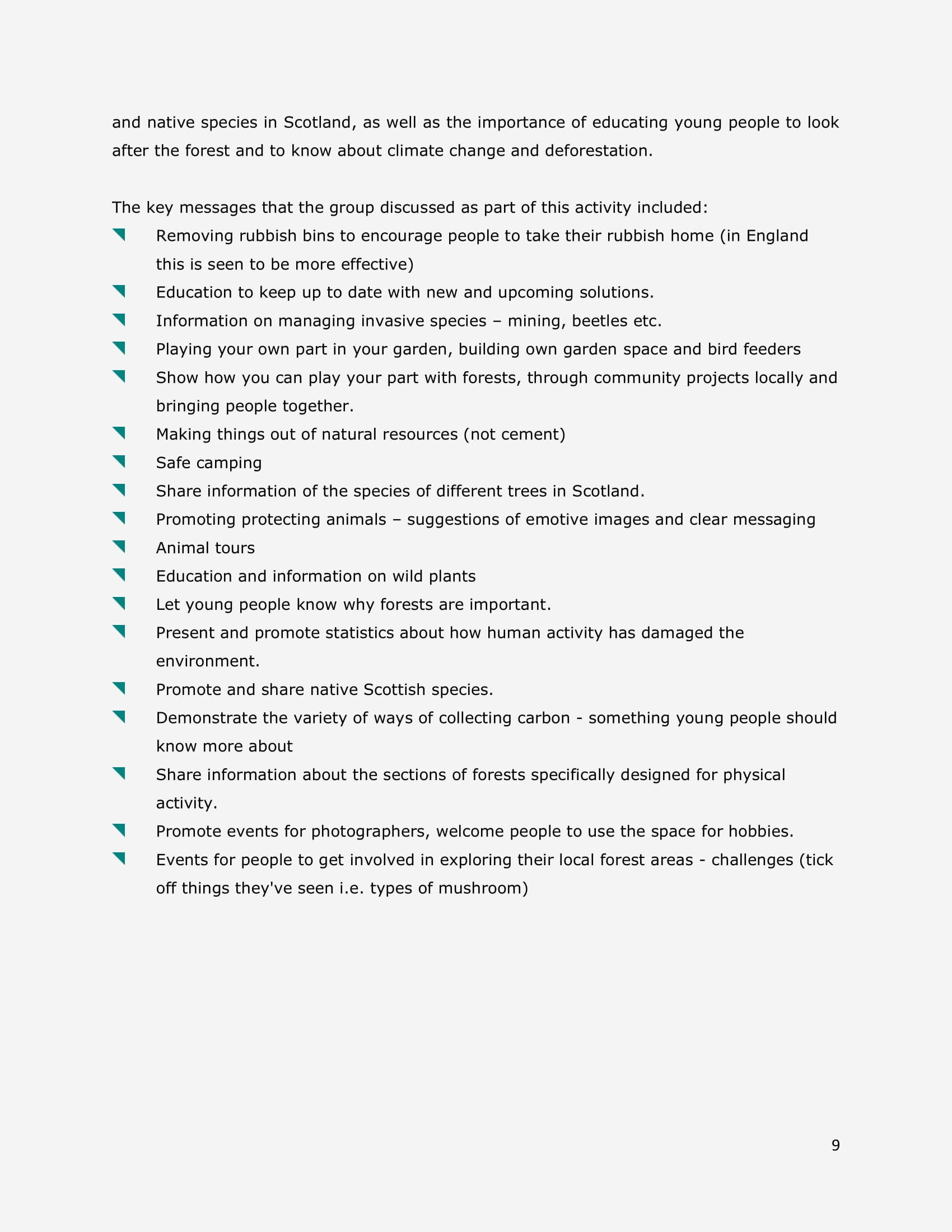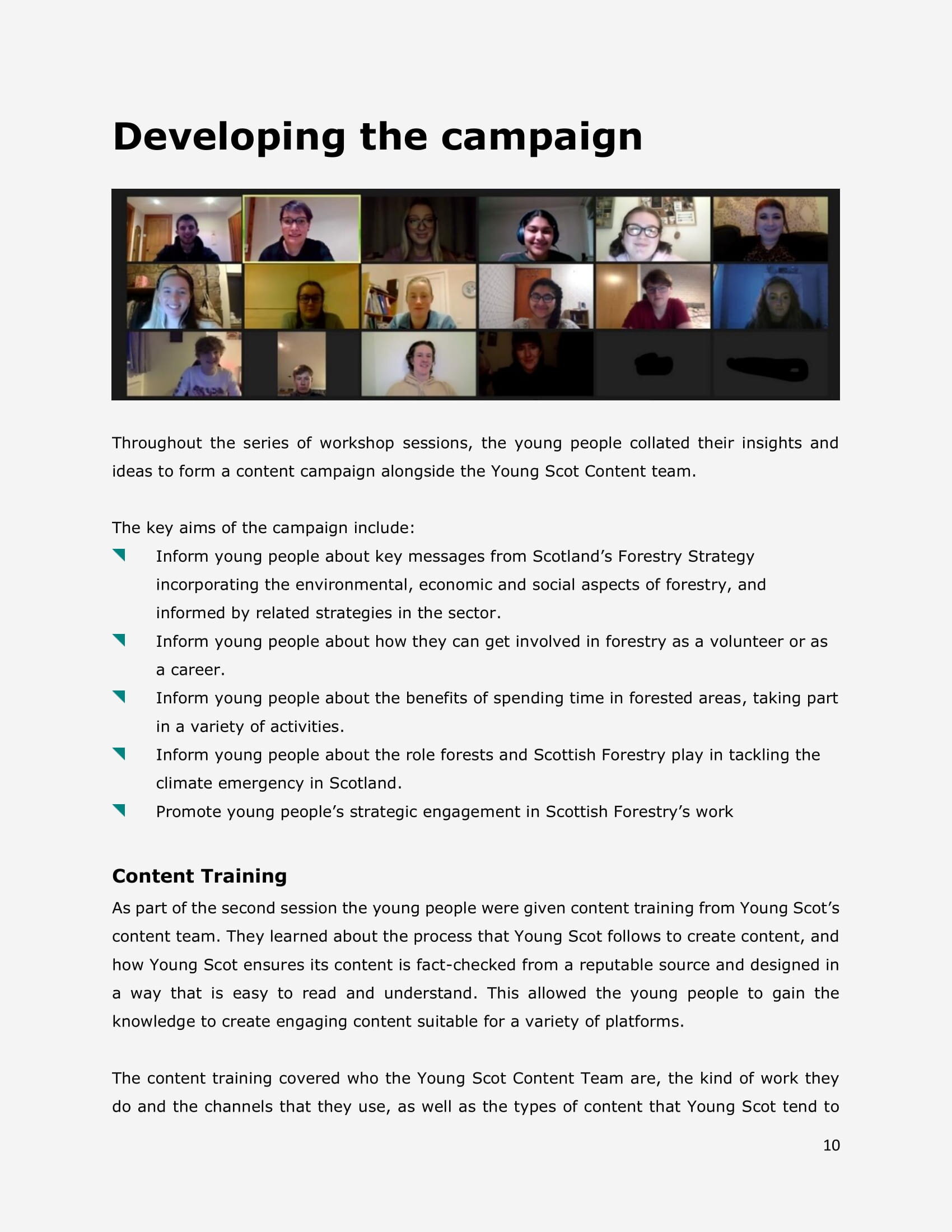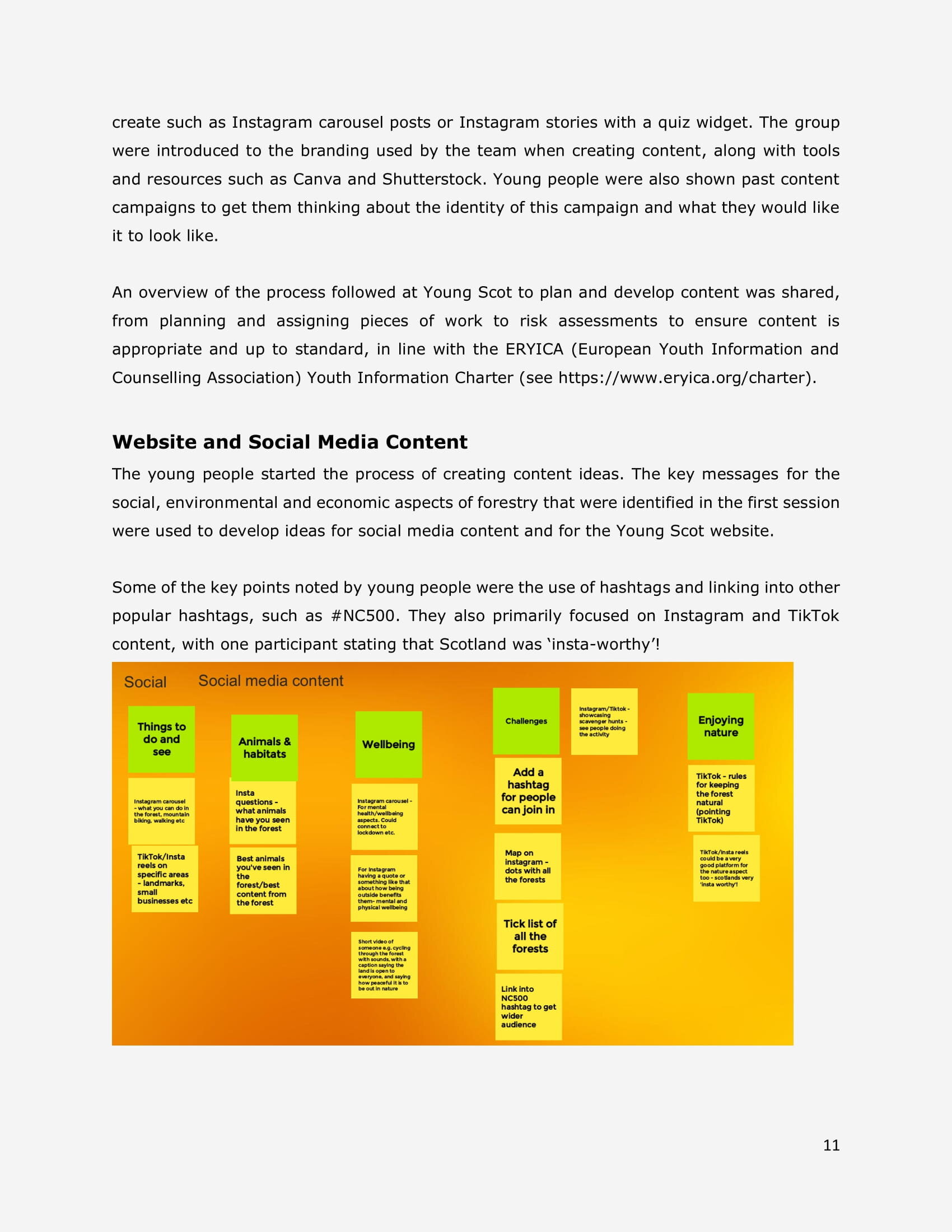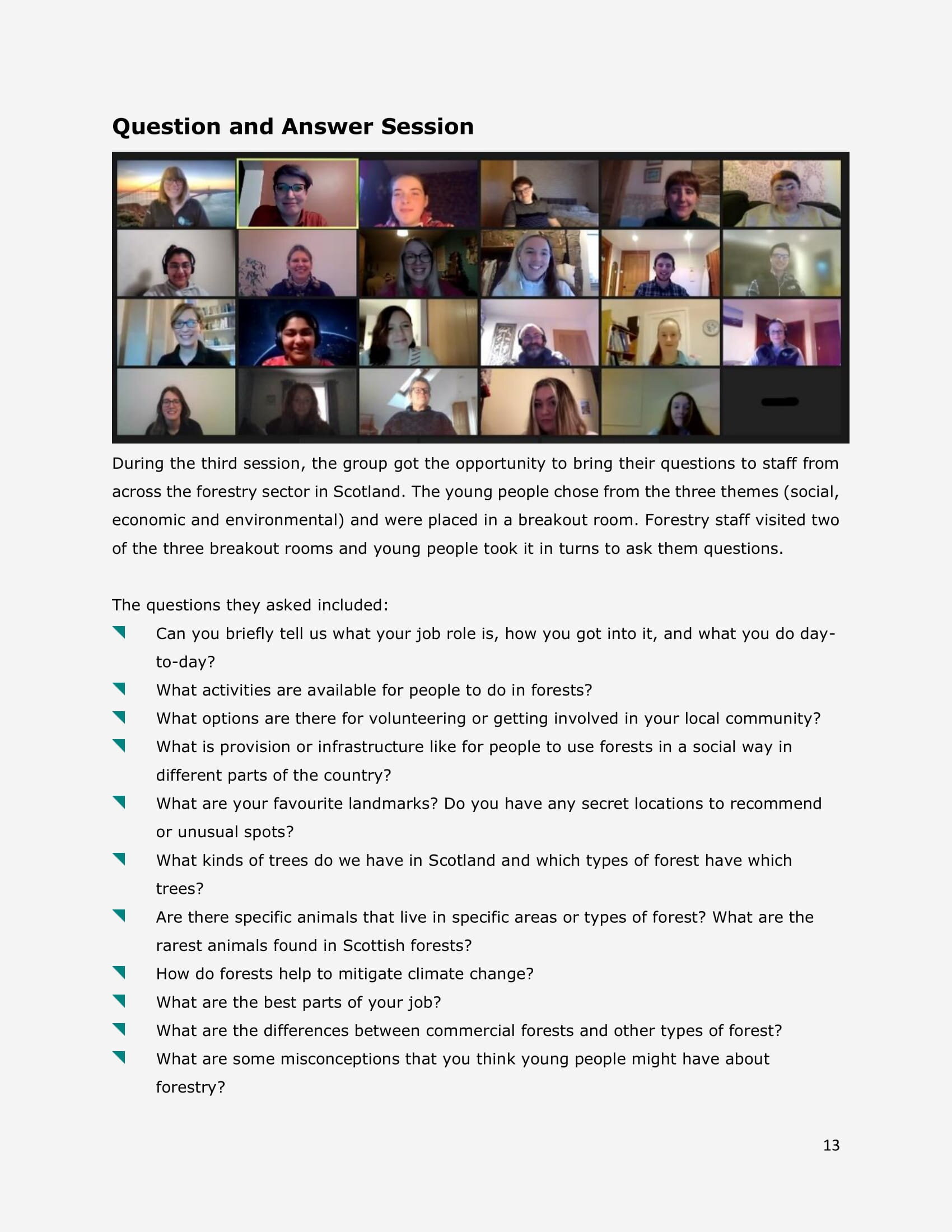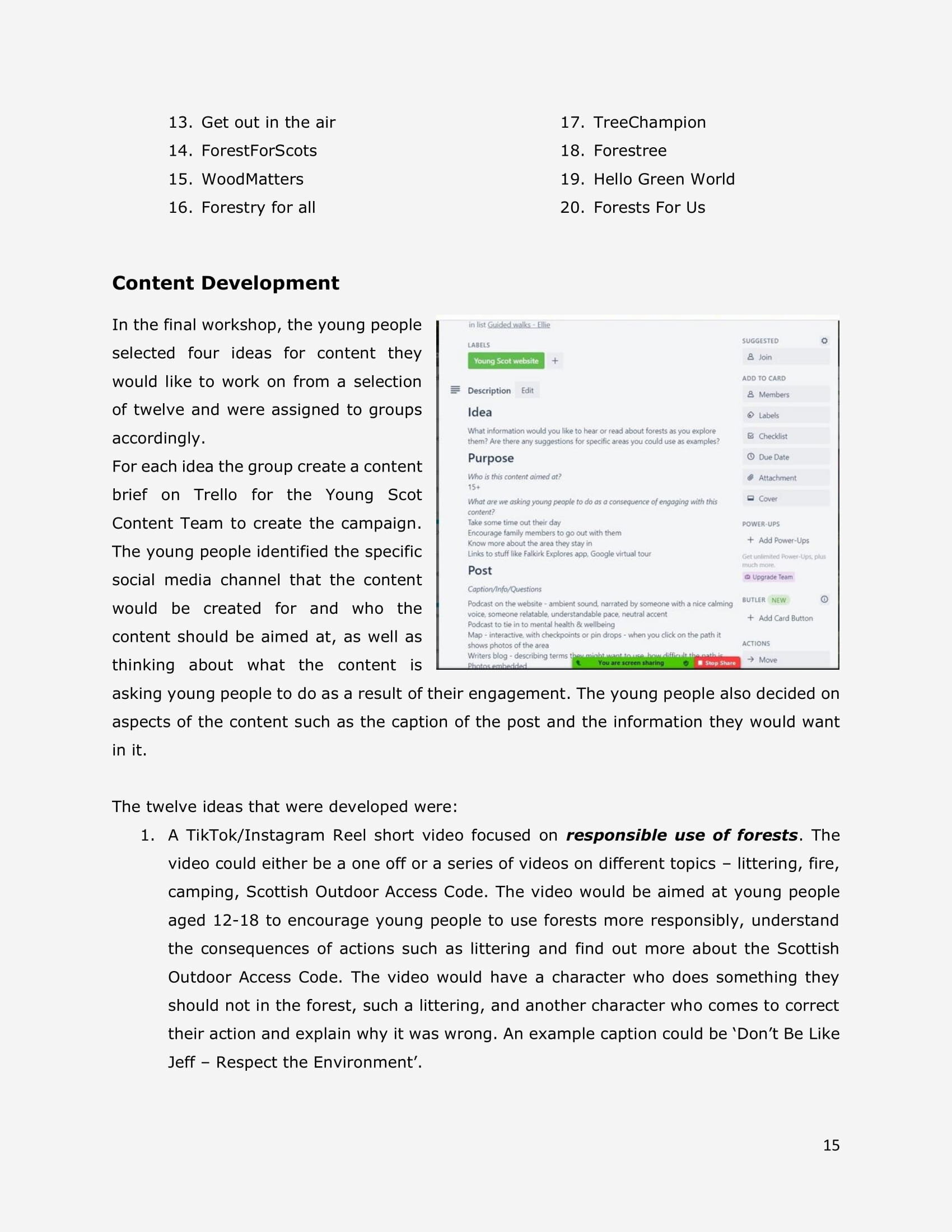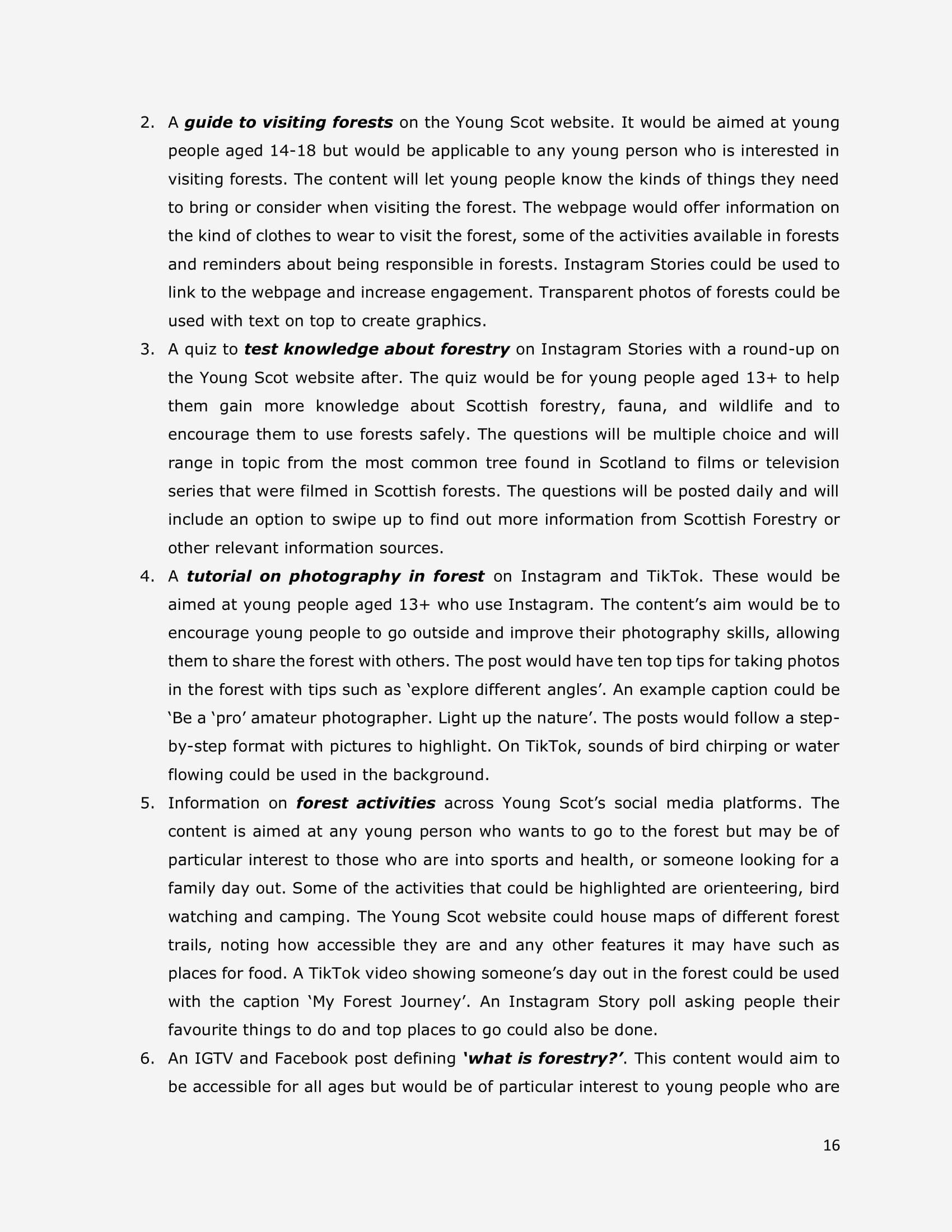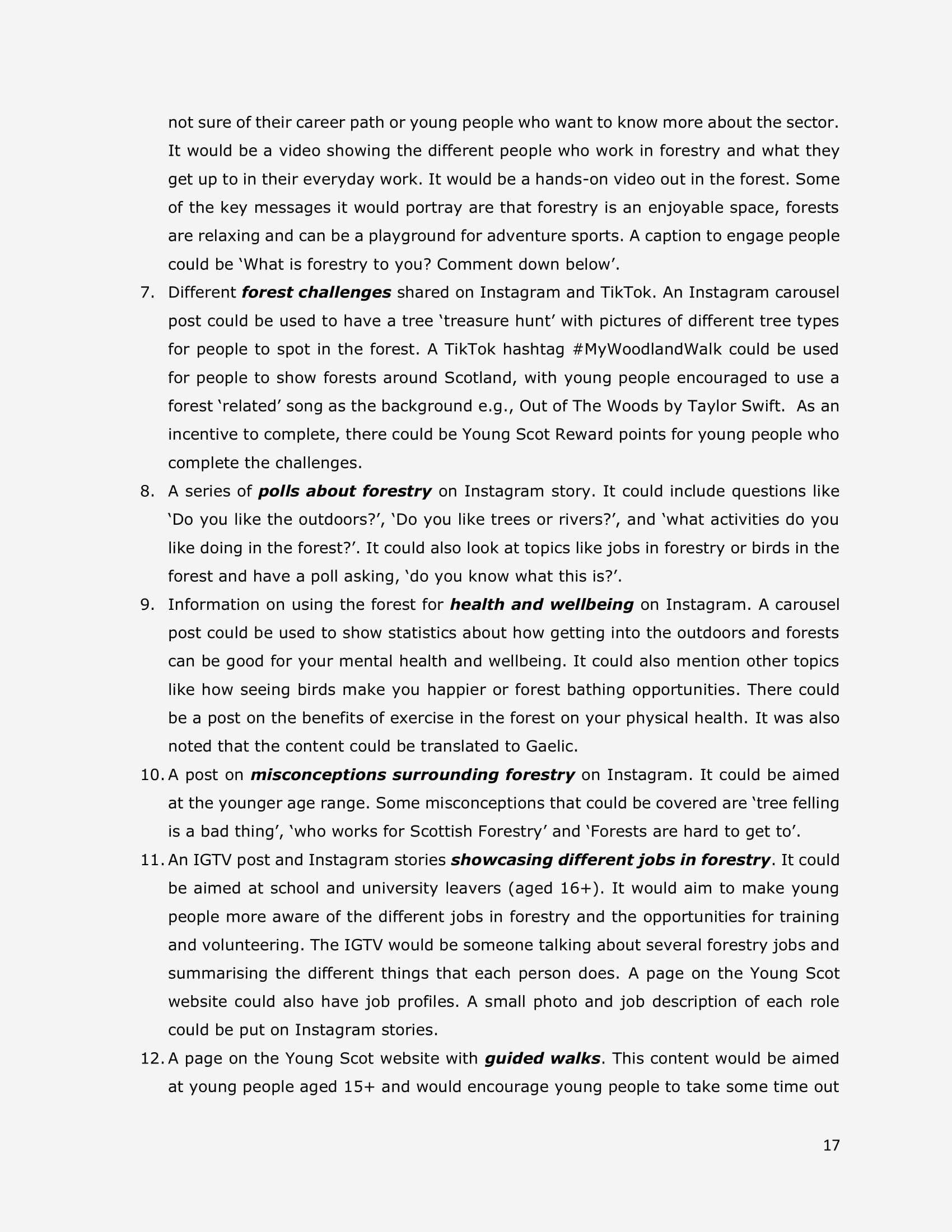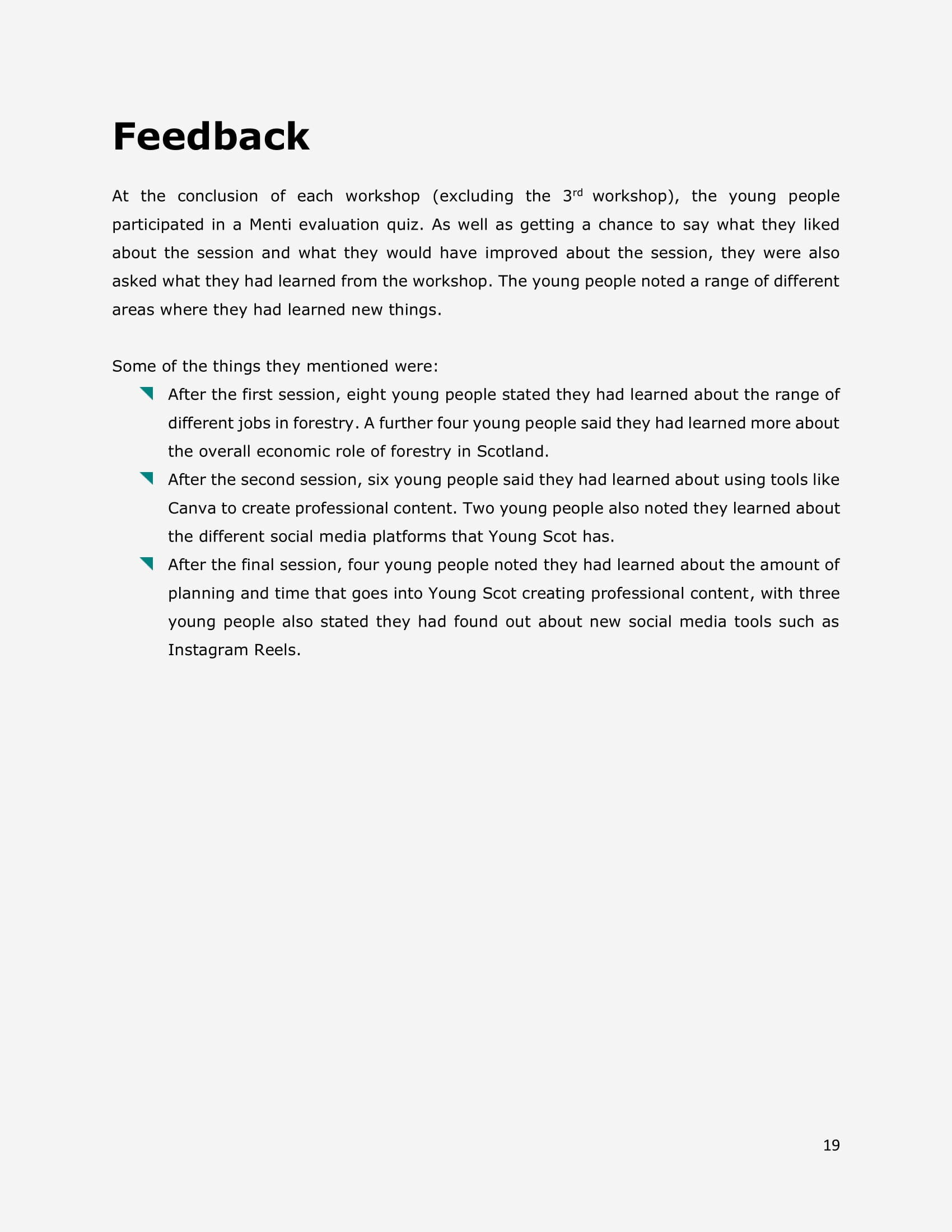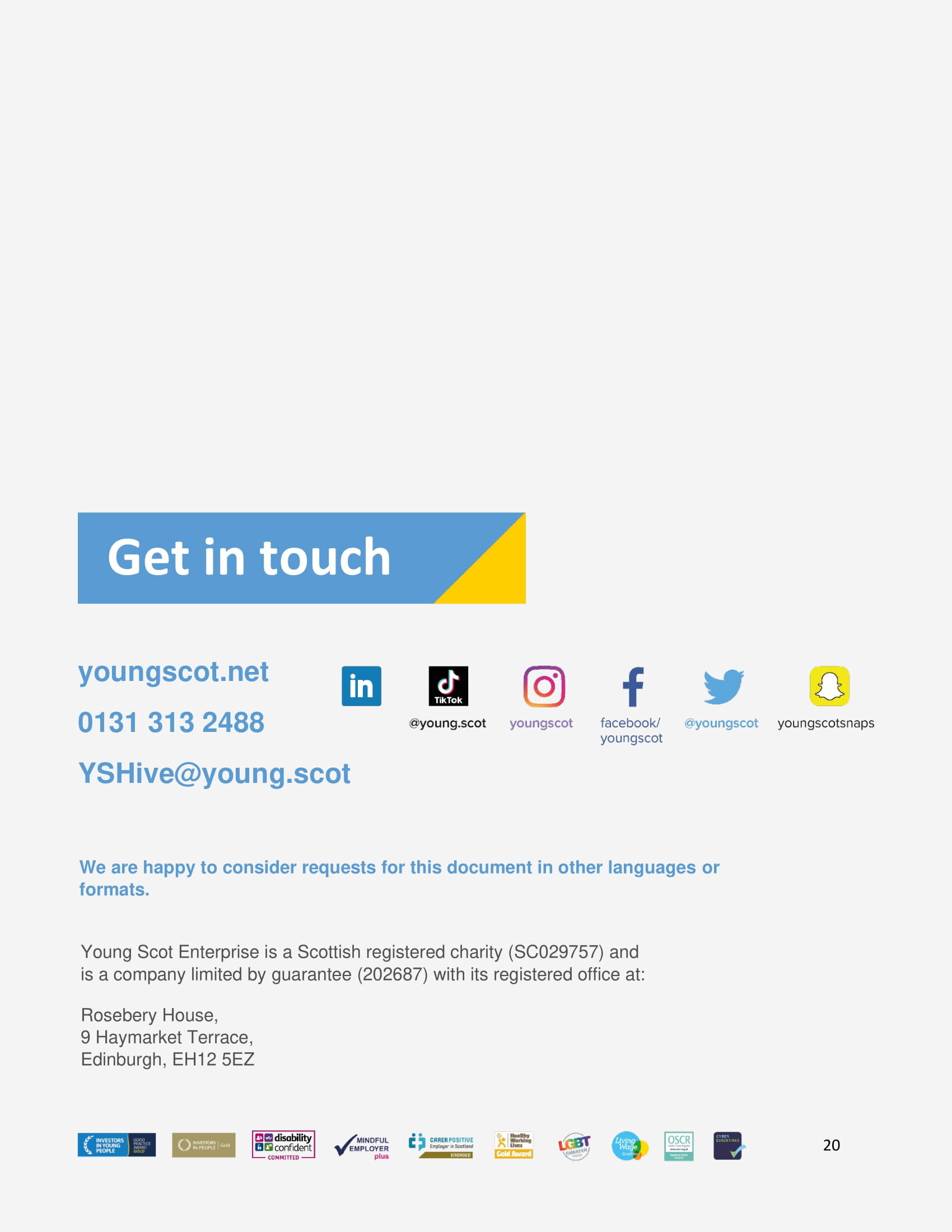Scottish Forestry Workshops
As part of Scotland’s Forestry Strategy, Scottish Forestry worked with Young Scot in 2018/19 to identify new ways of communicating the strategy to a young audience. The recommendations from this phase of work were presented to Scottish Forestry in The Future of Forestry in Scotland Report
One of the key ideas developed by young people during this phase was the creation of online content. This would help to communicate some of the key messages of Scotland’s Forestry Strategy, share information about the forestry sector, and communicate opportunities for young people to be involved in the sector.
In February 2021, Young Scot and Scottish Forestry engaged with young people to develop the recommendations from the first phase and co-design a content campaign to communicate these key messages and information.
The outcomes of this project were:
To increase the young volunteer’s knowledge and awareness about forestry in Scotland
To increase the young volunteers’ skills and knowledge around creating a range of content and how different platforms can be used to communicate messages
To provide Scottish Forestry with opportunities to explore how young people can continue to be involved in the organisation going forward.
The integration of tailored information about Scottish Forestry and forestry in general into national campaign pages on young.scot
The promotion of key messages and information, co-designed by young people, via a range of Young Scot social media platforms
You can scroll through a preview of our report, download a full pdf version using the Download button or access a plain text version of our report below.
Plain Text Version
Scottish Forestry Content Campaign Workshops
February – March 2021
Insight Report
Introduction
In 2018-2019, Young Scot and Scottish Forestry worked with young people to explore their views as part of Scotland’s Forestry Strategy and identified new ideas for communicating key aspects of the strategy to young audiences. The insights and outcomes from this phase of work were presented to Scottish Forestry in The Future of Forestry in Scotland Co-design Report, created in 2019.
Young Scot have worked with Scottish Forestry to further develop the recommendations that young people made in the first phase of work. One of the priority ideas the young people developed was creating online content to communicate some of the key messages of Scotland’s Forestry Strategy; to share information about the forestry sector; and to communicate opportunities for young people to be involved in the sector.
Working closely with Scottish Forestry, staff from Young Scot’s Co-design Service and Digital Information Service engaged young people in this phase of work to develop the recommendations from the first phase and co-design a content campaign to communicate these key messages and information.
The outcomes of this project were:
An increase in the young volunteer’s knowledge and awareness about forestry in Scotland
An increase in the young volunteers’ skills and knowledge around creating a range of content and how different platforms can be used to communicate messages
To provide Scottish Forestry with opportunities to explore how young people can continue to be involved in the organisation going forward.
The integration of tailored information about Scottish Forestry and forestry in general into national campaign pages on young.scot
The promotion of key messages and information, co-designed by young people, via a range of Young Scot social media platforms
Delivery method
Due to the COVID-19 restrictions in place during the time of the session, there were adjustments made to the Young Scot operating model and working practices. To ensure that delivery of engagement through co-design continued with minimal disruption, providing young people with opportunities to participate during this time, the session was delivered remotely using Zoom video conferencing and other digital communication tools, such as Menti, a digital questionnaire platform. Young Scot staff members were involved in the delivery of the activities to ensure that the young people taking part were supported and encouraged to share their insights and experiences.
The model for delivery meant that the young people met virtually in a shared space as a full group but then completed each of the activities in small group “breakout spaces” led by Young Scot staff, with feedback after each activity with the full group. Additional support measures were offered to all participants, in order to take part, ensuring that the model was inclusive and accessible.
Overview of workshops
Young Scot delivered a series of engaging workshops with young people to create tailored digital content that communicates how young people can be part of the change occurring with the expansion of forests and forestry in Scotland; sharing information, key messages; and opportunities connected to forestry and Scottish Forestry’s work. The young people were supported to understand the landscape of forestry in Scotland, to develop their skills in content creation, and lead on the creation of a digital information campaign to inspire other young people to get involved.
The first workshop took place on Wednesday 10th February from 4-7pm. This workshop brought the young people together for the first time to work together as a team and get to know each other and the Young Scot staff. It aimed to build the young people’s capacity and understanding of the forestry landscape in Scotland, including Scotland’s Forestry Strategy. The session gave the young people the opportunity to re-visit the recommendations from the first phase of work, allowing them to redefine the priorities and key messages that were developed further in the campaign. This is what is known as the Explore stage (see Young Scot Co-Design Process in Appendix 1). The themes that were explored were the social, economic and environmental aspects of forestry. The young people were also introduced to volunteering with Young Scot, the Basecamp team management site and completed a group agreement.
The second workshop focused on the Create stage of the process and took place on Wednesday 17th February from 4-7pm. This workshop aimed to train the young people in some of the techniques and approaches to content creation across multiple digital platforms. The young people were introduced to Young Scot’s digital platforms and learned about the types of content that Young Scot produces. From this, they were able to develop their key messages from the first session into content ideas.
The third workshop, centred on the Disrupt stage, took place on Wednesday 24th February from 4-7pm. This workshop was an opportunity for the young people to meet staff from the forestry industry and hear first-hand about the opportunities and challenges in the sector. Meeting with forestry staff allowed the young people to find out more about forestry to help develop their content ideas. The young people had developed questions at the previous session and used them to work with forestry colleagues to further develop the key messages and information for the content campaign.
The fourth, the Act stage, took place on Wednesday 3rd March from 4-7pm. This was the final project workshop where the young people agreed on and produced drafts of the final content ideas, as well as planning for what they would like to see as part of the launch.
Demographics
Twenty young people who participated in the series of workshops completed the Equality and Diversity survey. Participants ranged in age from 11-25.
14 identified as female, six identified as male.
One identified as transgender, one young person identifying as a lesbian, one identifying as gay and two identifying as bisexual.
Three young people noted that they had a long-term condition, including visual impairments and mental health conditions.
Five young people identified as Black, Asian and minority ethnic (BAME).
One identified as a young carer.
There were representatives from 14 local authorities across Scotland: Aberdeen City, Aberdeenshire, Angus, Dundee, East Dunbartonshire, East Lothian, Falkirk, Glasgow, Highland, North Ayrshire, North Lanarkshire, Perth and Kinross, Stirling and West Lothian.
Most (13) shared they were in school, five were in university, one was in college and one was in full-time education.
Two young people shared they were from the lower two quintiles of the Scottish Index of Multiple Deprivation (SIMD).
Motivations
The young people who participated in the workshops had varying motivations for joining the group. All the young people who participated either had an interest in forestry/conservation or digital content/social media. One participant said, “I'm passionate about preserving and improving the world we live in - both ecologically and technology” (Participant, 16, Falkirk).
Many young people said they wanted an opportunity to share their ideas on the topic. Others said they were interested in a career in forestry, with one young person noting “I am also at the point of my life where I'm trying to pick a suitable career for myself, and I saw this on Instagram as an ad, and thought 'why not try this out!?'” (Participant, 14, East Dunbartonshire).
Several young people also mentioned an interest in a career in social media and other digital markets. Other young people were interested in meeting new people and building their skills, with one of the group members saying, “Currently I am furloughed, and I want to use this time to develop myself” (Participant, 25, Glasgow). The breadth of motivation, knowledge and experience that the young people brought allowed for a wide range of opinions and voices to be heard.
Key Themes
In the first session, the young people worked in small groups in breakout rooms to explore each of the three key themes areas – the economic, social and environmental aspects of forestry. The activity was facilitated by Young Scot staff with a Google Jamboard used to allow for the young people to collaborate remotely.
Economic
The young people started off by exploring the economic aspect of forestry. Young people discussed different aspects of forestry that generate income, such as outdoor activity centres, tourist attractions and amenities such as cafes at forestry sites. Young people mentioned the range of jobs in the industry and the contribute of this work to the economy. They also mentioned the raw materials that come from the forest and how they are turned into goods, as well as the infrastructure of the forest (haulage, planting, construction etc) also contributing to the economy.
The key messages identified by the group to be demonstrated in the content included:
Showing the range of industry.
Getting young people to talk about their job within the sector and how it helps.
Show the people on the ground doing the work – maybe a day in the life idea.
How it's becoming more important and how jobs can help climate change.
Stating how much money the industry creates as a whole.
Shorts, clips, in photographs and writing
Talk about how it’s a growing sector and up and coming.
Talk about how there are many jobs in the whole industry.
Compostable packing - recycling / upcycling
Informal in tone rather than formal.
Supporting your local forest.
Showing the time scales of wood processing - from beginning to end
Hearing about career options, and hearing from professionals in the industry.
Showing young people or a family having a day out to the forest, advertising local businesses, speaking to local business owners – demonstrating that if that forest wasn’t there, where would their income come from
COVID-19 - Forestry is ongoing, wood is still needed, and forestry has maintained 65% of capacity throughout.
Help people rethink future job choices – demonstrating that forestry jobs are secure.
Not just the typical imagery of forest jobs, but showing what other jobs there are, who is in this industry, and what skills we can bring to it.
Social
The young people then discussed the social aspect of forestry. For this theme, they talked about the benefits of being in the forest for mental health. They mentioned activities that can be done in the forest such as hiking and mountain biking, and many mentioned experiences of going to forests on school trips and camps with groups such as the Scouts.
The key messages that the group discussed as part of this activity included:
Framing forestry like “everyone belongs there in Scotland”.
Taking a break from reality and screens – linked to mental wellbeing
Species information and education
Promotion of activities and things they can do.
Feeling of a breath of fresh air
Introducing fun features of small walks, like an adult treasure hunt. Giving visits an objective or purpose
Historical landmark promotions
The positives of getting outside.
Creating a social media challenge (nominate to run 5k, donate £5)
Something to enjoy doing with the current covid-19 restrictions.
Environmental
Finally, the young people discussed the environmental aspect of forestry. The points they noted were that forestry plays a big role in reducing CO2 emissions, as well as providing a natural habitat for many animals. The young people highlighted that there are several protected national parks in Scotland which can contribute to the conservation of greenspace and native species in Scotland, as well as the importance of educating young people to look after the forest and to know about climate change and deforestation.
The key messages that the group discussed as part of this activity included:
Removing rubbish bins to encourage people to take their rubbish home (in England this is seen to be more effective)
Education to keep up to date with new and upcoming solutions.
Information on managing invasive species – mining, beetles etc.
Playing your own part in your garden, building own garden space and bird feeders
Show how you can play your part with forests, through community projects locally and bringing people together.
Making things out of natural resources (not cement)
Safe camping
Share information of the species of different trees in Scotland.
Promoting protecting animals – suggestions of emotive images and clear messaging
Animal tours
Education and information on wild plants
Let young people know why forests are important.
Present and promote statistics about how human activity has damaged the environment.
Promote and share native Scottish species.
Demonstrate the variety of ways of collecting carbon - something young people should know more about
Share information about the sections of forests specifically designed for physical activity.
Promote events for photographers, welcome people to use the space for hobbies.
Events for people to get involved in exploring their local forest areas - challenges (tick off things they've seen i.e. types of mushroom)
Developing the campaign
Throughout the series of workshop sessions, the young people collated their insights and ideas to form a content campaign alongside the Young Scot Content team.
The key aims of the campaign include:
Inform young people about key messages from Scotland’s Forestry Strategy incorporating the environmental, economic and social aspects of forestry, and informed by related strategies in the sector.
Inform young people about how they can get involved in forestry as a volunteer or as a career.
Inform young people about the benefits of spending time in forested areas, taking part in a variety of activities.
Inform young people about the role forests and Scottish Forestry play in tackling the climate emergency in Scotland.
Promote young people’s strategic engagement in Scottish Forestry’s work
Content Training
As part of the second session the young people were given content training from Young Scot’s content team. They learned about the process that Young Scot follows to create content, and how Young Scot ensures its content is fact-checked from a reputable source and designed in a way that is easy to read and understand. This allowed the young people to gain the knowledge to create engaging content suitable for a variety of platforms.
The content training covered who the Young Scot Content Team are, the kind of work they do and the channels that they use, as well as the types of content that Young Scot tend to create such as Instagram carousel posts or Instagram stories with a quiz widget. The group were introduced to the branding used by the team when creating content, along with tools and resources such as Canva and Shutterstock. Young people were also shown past content campaigns to get them thinking about the identity of this campaign and what they would like it to look like.
An overview of the process followed at Young Scot to plan and develop content was shared, from planning and assigning pieces of work to risk assessments to ensure content is appropriate and up to standard, in line with the ERYICA (European Youth Information and Counselling Association) Youth Information Charter (see https://www.eryica.org/charter).
Website and Social Media Content
The young people started the process of creating content ideas. The key messages for the social, environmental and economic aspects of forestry that were identified in the first session were used to develop ideas for social media content and for the Young Scot website.
Some of the key points noted by young people were the use of hashtags and linking into other popular hashtags, such as #NC500. They also primarily focused on Instagram and TikTok content, with one participant stating that Scotland was ‘insta-worthy’!
Research Identification
After brainstorming different content ideas, the young people identified areas that they needed more knowledge about. In groups, the participants worked through the different ideas for their chosen theme (social, economic and environmental) to decide what information they needed to find out to inform their content, as well as several questions that they would be putting to forestry staff at a question-and-answer session.
Some information that the young people wanted to find out were:
Where are the key landmarks? What can you do there? How can you travel there? What is the distance from key locations? What public transport is available etc.
What species of plants and trees are there is Scottish forests?
What small businesses exist that might interact with us at forestry sites?
What do young people listen to when they go out for walks? (To explore with Instagram questions)
What historical landmarks are there that can be linked to content that have interesting histories?
What are the rarest animals found in Scottish forests?
How can we take what we know about the mental health benefits and turn it into content?
How has being outside benefited our mental health?
What are the main cycling routes in Scotland?
What does Scottish Forestry’s staff day involve?
What are the variety of jobs in forestry and which can we highlight for young people?
Interview people currently working in forestry
What training and experience do you need to get into a career in forestry?
What are these types of wood and products available in Scotland?
Where can you volunteer within forestry?
What it is like working in forestry?
What are the positives of commercial forestry we can share?
Question and Answer Session
During the third session, the group got the opportunity to bring their questions to staff from across the forestry sector in Scotland. The young people chose from the three themes (social, economic and environmental) and were placed in a breakout room. Forestry staff visited two of the three breakout rooms and young people took it in turns to ask them questions.
The questions they asked included:
Can you briefly tell us what your job role is, how you got into it, and what you do day-to-day?
What activities are available for people to do in forests?
What options are there for volunteering or getting involved in your local community?
What is provision or infrastructure like for people to use forests in a social way in different parts of the country?
What are your favourite landmarks? Do you have any secret locations to recommend or unusual spots?
What kinds of trees do we have in Scotland and which types of forest have which trees?
Are there specific animals that live in specific areas or types of forest? What are the rarest animals found in Scottish forests?
How do forests help to mitigate climate change?
What are the best parts of your job?
What are the differences between commercial forests and other types of forest?
What are some misconceptions that you think young people might have about forestry?
What jobs are available to people who are interested in forestry and are there common routes into the sector?
What jobs are there a demand for at the moment, and how do you think that might change in the next 5 years?
Storyboarding (Trello)
To develop their content ideas further, the young people worked with Young Scot staff to use the project planning tool Trello. In groups, the young people storyboarded different content ideas using the information they had learned from forestry staff and their own knowledge.
Campaign Names
As a quick-fire way to decide on a campaign name, the young people took part in an activity inspired by a popular Young Scot activity, ‘100 ways to squeeze a lemon’. The young people were placed into groups and had to try to come up with 100 different campaign names or hashtags. After this, the groups came together and a top twenty were selected. They were then put out to poll and the young people voted on them.
Below are the results ranked in order of preference by the young people:
1. GrowYourFuture
2. Leaf your house.
3. May the forest be with you
4. GrabATreeful
5. What would you do?
6. Branch out
7. #itsallnatural
8. ATouchOfNature
9. TreemendousScots
10. Your land, My land, Our land
11. OurForests
12. Treemendous
13. Get out in the air
14. ForestForScots
15. WoodMatters
16. Forestry for all
17. TreeChampion
18. Forestree
19. Hello Green World
20. Forests For Us
Content Development
In the final workshop, the young people selected four ideas for content they would like to work on from a selection of twelve and were assigned to groups accordingly.
For each idea the group create a content brief on Trello for the Young Scot Content Team to create the campaign. The young people identified the specific social media channel that the content would be created for and who the content should be aimed at, as well as thinking about what the content is asking young people to do as a result of their engagement. The young people also decided on aspects of the content such as the caption of the post and the information they would want in it.
The twelve ideas that were developed were:
1. A TikTok/Instagram Reel short video focused on responsible use of forests. The video could either be a one off or a series of videos on different topics – littering, fire, camping, Scottish Outdoor Access Code. The video would be aimed at young people aged 12-18 to encourage young people to use forests more responsibly, understand the consequences of actions such as littering and find out more about the Scottish Outdoor Access Code. The video would have a character who does something they should not in the forest, such a littering, and another character who comes to correct their action and explain why it was wrong. An example caption could be ‘Don’t Be Like Jeff – Respect the Environment’.
2. A guide to visiting forests on the Young Scot website. It would be aimed at young people aged 14-18 but would be applicable to any young person who is interested in visiting forests. The content will let young people know the kinds of things they need to bring or consider when visiting the forest. The webpage would offer information on the kind of clothes to wear to visit the forest, some of the activities available in forests and reminders about being responsible in forests. Instagram Stories could be used to link to the webpage and increase engagement. Transparent photos of forests could be used with text on top to create graphics.
3. A quiz to test knowledge about forestry on Instagram Stories with a round-up on the Young Scot website after. The quiz would be for young people aged 13+ to help them gain more knowledge about Scottish forestry, fauna, and wildlife and to encourage them to use forests safely. The questions will be multiple choice and will range in topic from the most common tree found in Scotland to films or television series that were filmed in Scottish forests. The questions will be posted daily and will include an option to swipe up to find out more information from Scottish Forestry or other relevant information sources.
4. A tutorial on photography in forest on Instagram and TikTok. These would be aimed at young people aged 13+ who use Instagram. The content’s aim would be to encourage young people to go outside and improve their photography skills, allowing them to share the forest with others. The post would have ten top tips for taking photos in the forest with tips such as ‘explore different angles’. An example caption could be ‘Be a ‘pro’ amateur photographer. Light up the nature’. The posts would follow a step-by-step format with pictures to highlight. On TikTok, sounds of bird chirping or water flowing could be used in the background.
5. Information on forest activities across Young Scot’s social media platforms. The content is aimed at any young person who wants to go to the forest but may be of particular interest to those who are into sports and health, or someone looking for a family day out. Some of the activities that could be highlighted are orienteering, bird watching and camping. The Young Scot website could house maps of different forest trails, noting how accessible they are and any other features it may have such as places for food. A TikTok video showing someone’s day out in the forest could be used with the caption ‘My Forest Journey’. An Instagram Story poll asking people their favourite things to do and top places to go could also be done.
6. An IGTV and Facebook post defining ‘what is forestry?’. This content would aim to be accessible for all ages but would be of particular interest to young people who are not sure of their career path or young people who want to know more about the sector. It would be a video showing the different people who work in forestry and what they get up to in their everyday work. It would be a hands-on video out in the forest. Some of the key messages it would portray are that forestry is an enjoyable space, forests are relaxing and can be a playground for adventure sports. A caption to engage people could be ‘What is forestry to you? Comment down below’.
7. Different forest challenges shared on Instagram and TikTok. An Instagram carousel post could be used to have a tree ‘treasure hunt’ with pictures of different tree types for people to spot in the forest. A TikTok hashtag #MyWoodlandWalk could be used for people to show forests around Scotland, with young people encouraged to use a forest ‘related’ song as the background e.g., Out of The Woods by Taylor Swift. As an incentive to complete, there could be Young Scot Reward points for young people who complete the challenges.
8. A series of polls about forestry on Instagram story. It could include questions like ‘Do you like the outdoors?’, ‘Do you like trees or rivers?’, and ‘what activities do you like doing in the forest?’. It could also look at topics like jobs in forestry or birds in the forest and have a poll asking, ‘do you know what this is?’.
9. Information on using the forest for health and wellbeing on Instagram. A carousel post could be used to show statistics about how getting into the outdoors and forests can be good for your mental health and wellbeing. It could also mention other topics like how seeing birds make you happier or forest bathing opportunities. There could be a post on the benefits of exercise in the forest on your physical health. It was also noted that the content could be translated to Gaelic.
10. A post on misconceptions surrounding forestry on Instagram. It could be aimed at the younger age range. Some misconceptions that could be covered are ‘tree felling is a bad thing’, ‘who works for Scottish Forestry’ and ‘Forests are hard to get to’.
11. An IGTV post and Instagram stories showcasing different jobs in forestry. It could be aimed at school and university leavers (aged 16+). It would aim to make young people more aware of the different jobs in forestry and the opportunities for training and volunteering. The IGTV would be someone talking about several forestry jobs and summarising the different things that each person does. A page on the Young Scot website could also have job profiles. A small photo and job description of each role could be put on Instagram stories.
12. A page on the Young Scot website with guided walks. This content would be aimed at young people aged 15+ and would encourage young people to take some time out of their day to go out into the forest. There would be a podcast on the YS website of someone with a calming voice guiding you on the walk. There would also be interactive maps, with top tips for each area and information about difficulty, time it takes etc.
Next Steps
Following the delivery of the co-design sessions, where the young people worked through the YSHive process to explore, create and develop 12 key content ideas, the design briefs will be implemented by the Young Scot Content team.
The ideas will be created and refined in a campaign that will be shared through Young Scot’s social media channels and platforms as agreed in partnership with Scottish Forestry.
Feedback
At the conclusion of each workshop (excluding the 3rd workshop), the young people participated in a Menti evaluation quiz. As well as getting a chance to say what they liked about the session and what they would have improved about the session, they were also asked what they had learned from the workshop. The young people noted a range of different areas where they had learned new things.
Some of the things they mentioned were:
After the first session, eight young people stated they had learned about the range of different jobs in forestry. A further four young people said they had learned more about the overall economic role of forestry in Scotland.
After the second session, six young people said they had learned about using tools like Canva to create professional content. Two young people also noted they learned about the different social media platforms that Young Scot has.
After the final session, four young people noted they had learned about the amount of planning and time that goes into Young Scot creating professional content, with three young people also stated they had found out about new social media tools such as Instagram Reels.
Get in touch
youngscot.net
0131 313 2488
YSHive@young.scot
We are happy to consider requests for this document in other languages or formats.
Young Scot Enterprise is a Scottish registered charity (SC029757) and is a company limited by guarantee (202687) with its registered office at:
Rosebery House, 9 Haymarket Terrace, Edinburgh, EH12 5EZ
